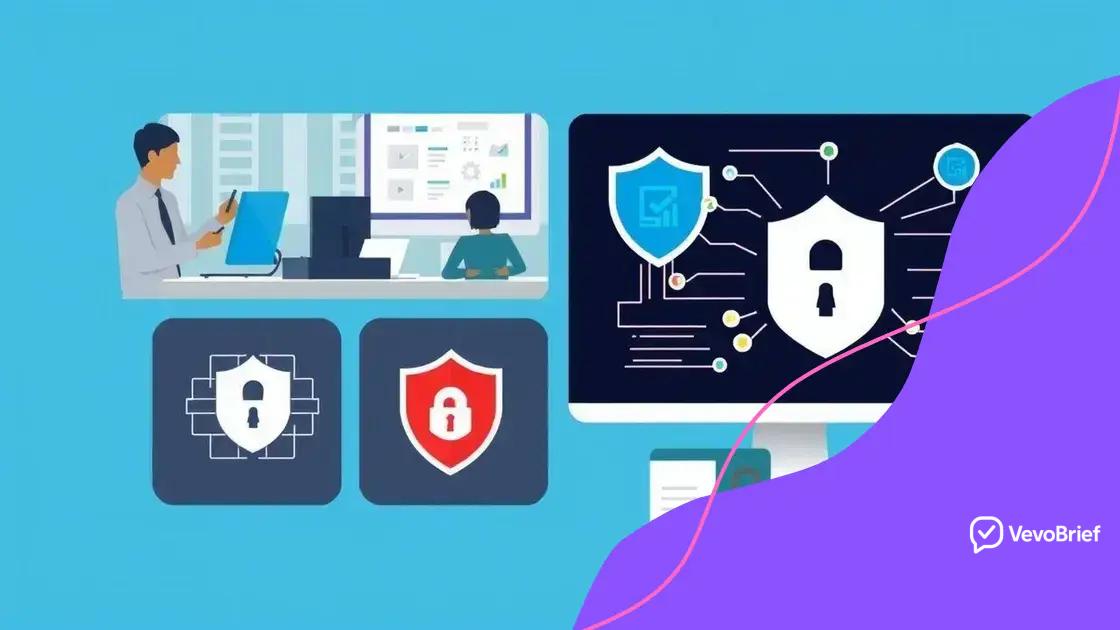Cybersecurity experts warn of threats to your data

Cybersecurity experts warn of evolving threats, emphasizing the need for organizations to adopt AI, prioritize data privacy, secure remote work, and prepare for ransomware to protect valuable information.
Cybersecurity experts warn of threats that lurk in the digital shadows, ready to exploit vulnerabilities. As online risks multiply, it’s crucial to stay informed and proactive. Have you ever wondered what steps you can take to ensure your safety online?
Understanding the evolving landscape of cybersecurity
The world of cybersecurity is constantly changing. As technology advances, so do the threats that can compromise our data. Understanding this evolving landscape is crucial for businesses and individuals alike.
The Rise of New Threats
Cybercriminals are becoming more sophisticated. New techniques are emerging, challenging our defenses. Here are some common threats:
- Phishing attacks that deceive users into revealing personal info.
- Ransomware that locks you out of your files until paid.
- Malware that can damage your systems and steal information.
Awareness of these threats is the first step in protecting yourself. Knowing what to look for can make a big difference.
Protective Measures
As threats evolve, so must our strategies. Many businesses are now implementing advanced security measures, such as:
- Multi-factor authentication to ensure secure access.
- Regular updates and patches for software to fix vulnerabilities.
- Employee training to recognize and respond to threats.
By taking these proactive steps, the risk of becoming a victim decreases significantly. Furthermore, understanding current trends in cybersecurity helps in developing effective strategies.
It’s essential to stay informed about the latest developments in this rapidly changing field. Cybersecurity is not just a technology issue; it’s also about building a culture of security awareness across organizations. Sharing knowledge and best practices can lead to a safer online environment for everyone. Keeping up with news, attending cybersecurity conferences, and subscribing to relevant publications can provide valuable insights.
Top threats facing individuals and businesses today
Understanding the top threats facing individuals and businesses today is essential to stay safe in an increasingly digital world. Cybercriminals constantly devise new tactics to exploit vulnerabilities. Awareness of these threats helps in building effective defenses.
Common Cyber Threats
Among the most prevalent dangers are:
- Phishing: Attempts to trick users into providing sensitive data through fake emails or websites.
- Ransomware: Malicious software that locks users out of their data until a ransom is paid.
- Data Breaches: Unauthorized access to confidential information, often leading to identity theft.
- Denial of Service (DoS) attacks: Overloading a system, rendering it unusable for legitimate users.
Each of these threats can have severe consequences. For example, a single phishing attack can compromise an entire organization’s network if employees fall for the scam. Therefore, it’s crucial for both individuals and businesses to understand these threats.
Emerging Threats
As technology evolves, so do the tactics used by cybercriminals. New forms of attacks are emerging, such as:
- IoT Vulnerabilities: With more devices connected to the internet, the potential for security breaches increases.
- Deepfakes: Manipulated media that can be used to deceive individuals or impersonate trusted sources.
- Supply Chain Attacks: Targeting software providers or vendors to gain access to larger systems.
Staying informed about these emerging threats is vital. Regularly updating cybersecurity practices and educating employees about the risks can help organizations protect their assets.
Being aware of the top threats facing individuals and businesses is the first step toward developing effective strategies. By implementing robust cybersecurity measures and fostering a culture of security, you can greatly reduce your risk of falling victim to these dangers.
Effective strategies for safeguarding your data

Implementing effective strategies for safeguarding your data is crucial in today’s digital landscape. As cyber threats increase, knowing how to protect your information is essential.
Layered Security Approaches
One of the best methods is to use a layered security approach. This means having multiple defenses in place. Here are some important components:
- Firewalls: Keep unauthorized users from accessing your network.
- Antivirus Software: Detect and remove malicious software from your devices.
- Encryption: Protect sensitive data by converting it into a coded format.
By combining these tools, you create a stronger barrier against cyber threats. It’s important to regularly update these systems to ensure they counter the latest threats.
Educating Employees
Training employees is another vital strategy. Users often serve as the first line of defense against cyber attacks. Regular training sessions can help them recognize:
- Phishing attempts that try to steal passwords.
- Social engineering tactics aimed at manipulating users.
- Safe practices for handling sensitive information.
When employees know what to look for, they can help prevent data breaches.
Another effective strategy is regular data backups. Keeping copies of your data stored in different locations ensures that even if you fall victim to ransomware or another attack, you can recover your vital information. Cloud solutions offer excellent options for secure backups.
Furthermore, implementing access controls can significantly reduce risks. By ensuring that only authorized personnel have access to sensitive data, you limit the potential for internal and external threats. Tools that monitor user access can help track any suspicious activity.
The role of technology in modern cybersecurity
Technology plays a vital role in modern cybersecurity. As threats evolve, innovative solutions are necessary to protect sensitive data and systems. Various technologies work together to enhance security measures effectively.
Artificial Intelligence and Machine Learning
AI and machine learning are becoming essential tools in cybersecurity. They help detect and respond to threats more quickly than traditional methods. With these technologies, systems can:
- Analyze patterns: Quickly identify unusual behavior that may indicate a breach.
- Automate responses: Implement immediate defensive measures without human intervention.
- Predict threats: Anticipate future attacks by studying past incidents.
These capabilities help organizations stay one step ahead of cybercriminals.
Cloud Security Technologies
Cloud computing has transformed how businesses operate. However, it brings unique security challenges. Technologies such as:
- Encryption: Keeps data safe during storage and transmission.
- Access controls: Ensure that only authorized users can access sensitive information.
- Real-time monitoring: Detects and responds to threats as they occur.
By leveraging these tools, organizations can safeguard their data more effectively in the cloud.
Another critical aspect of modern cybersecurity is the use of cybersecurity frameworks. These structured sets of best practices provide guidelines for improving security measures. Common frameworks include NIST and ISO 27001, which help organizations identify risks and develop effective responses. They promote a proactive approach to security that aligns technology with business objectives.
Additionally, technologies like blockchain are gaining attention for enhancing data integrity and security. By securely recording transactions, blockchain can protect against tampering and fraud, ensuring that data remains trustworthy.
Future trends in cybersecurity and how to prepare
Understanding future trends in cybersecurity is critical for staying protected in a rapidly evolving digital landscape. As threats become more sophisticated, preparing for what lies ahead is essential for individuals and organizations alike.
Increased Use of Artificial Intelligence
Artificial Intelligence (AI) will play a larger role in cybersecurity. AI systems can analyze vast amounts of data faster than humans, identifying potential threats before they escalate. However, this also means that cybercriminals will likely use AI to develop more advanced attacks. To prepare, organizations should:
- Invest in AI-driven security solutions to enhance threat detection.
- Train staff on how to use new technologies effectively.
- Encourage collaboration between AI systems and security teams to improve response times.
These steps will help businesses stay one step ahead of cyber threats.
Increased Focus on Data Privacy
As data privacy regulations continue to evolve, organizations will need to adapt their practices. Compliance with regulations like GDPR and CCPA will be paramount. Companies must prioritize:
- Implementing robust data governance frameworks.
- Regularly auditing data practices to ensure compliance.
- Training employees on data privacy policies and best practices.
Taking these actions will help maintain consumer trust and avoid costly penalties.
Another trend to watch is the rise of remote work. With many employees working from home, organizations must enhance their security posture. This includes securing personal devices, using virtual private networks (VPNs), and ensuring secure access to company resources. Employers should also provide training on remote work security best practices.
Lastly, preparations should involve anticipating the growing threat of ransomware attacks. These malicious attacks can lock up essential data, demanding ransom for its release. Organizations should conduct regular backups, create incident response plans, and invest in training to mitigate these threats effectively.
FAQ – Frequently Asked Questions about Cybersecurity
What are the main cybersecurity threats I should be aware of?
The main threats include phishing, ransomware, data breaches, and denial-of-service attacks. Each poses significant risks to individuals and organizations.
How can I protect my data from cyber attacks?
You can protect your data by using strong passwords, enabling two-factor authentication, regularly backing up your data, and implementing security software.
What role does AI play in cybersecurity?
AI helps in detecting threats rapidly by analyzing large datasets, automating responses, and predicting potential attacks to enhance security measures.
How can I prepare my business for the future of cybersecurity?
Stay informed about emerging threats, invest in advanced security solutions, train employees on cybersecurity best practices, and regularly update your security protocols.
